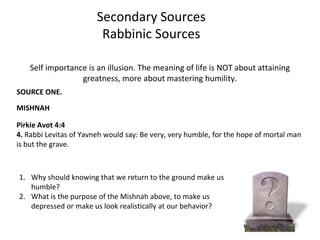
Anavah Secondary Sources
- 1. Secondary Sources Rabbinic Sources Self importance is an illusion. The meaning of life is NOT about attaining greatness, more about mastering humility. SOURCE ONE. MISHNAH Pirkie Avot 4:4 4. Rabbi Levitas of Yavneh would say: Be very, very humble, for the hope of mortal man is but the grave. 1. Why should knowing that we return to the ground make us humble? 2. What is the purpose of the Mishnah above, to make us depressed or make us look realistically at our behavior?
- 2. Second Source: TALMUD The talmud teaches you that just as water does not collect on an slant, but rather flows from it and collects in a low place, similarly, the words of Torah will not be found in the arrogant or in the hearts of any of the arrogant, but rather in the humble and lowly. ”As water flows to the lowest level, so Torah finds its way to the lowly of spirit.” -Hanina ben Iddi Talmud Taanit 7a 1. How is the image of water used in this piece of Talmud? 2. Why does the torah stay with someone who is humble? 3. How are thirst and humility alike?
- 3. Third Source: TALMUD “Our Rabbis taught: Adam was created [last of all beings] on the eve of Sabbath. And why? , in order that, if a man's mind becomes [too] proud, he may be reminded that the gnats came before him in the order of creation. ” 1. Why does the above piece of Talmud, help make a person feel less proud or arrogant? 1. How often do you reflect on your place in the larger design of the world around you? 2. Should thinking that you are just a smaller part of a very big picture be something you do in order to make you more humble?
- 4. Derekh Eretz Zutta (Hebrew: ) is a part of the Babylonian Talmud Second Source: DERECH ERETZ ZUTA 1:3 Do not resemble a big door, which lets in the wind, or a small door, which makes the worthy bend down; but resemble the threshold on which all may tread, or a low peg on which all can hang their things. 1. What is the meaning of a “big door” which lets in the wind? 2. Why should you not make the “worthy bend down”? 3. Why is it best to resemble a threshold or a low peg?
- 6. Activity #1. Complete this list below: Good Middot Middot that I need to work on 1. 1. 2. 2. 3. 3. 4. 4. 5. 5. 6. 6. 7. 7. 8. 8. 9. 9. 10. 10.
- 8. Formative Assessment Worth 30 Points Choice 1: There are things in nature that remind us to be humble. One example is from the Talmud on slide 3 (Review the Slide). Now try to put your own examples together, write about thing in nature or around us that that can teach us humility. For example: dew that comes in the darkness of night, and fades away as quietly as it came. A weeping willow, an arch. As you write, try to use a poetic style, detailed description, and metaphor. Explain how you are an "effective"learner from the world around you, how do these things improve you as a person Choice 2: On next slide...
- 9. Formative Assessment Worth 30 Points Choice 2: Rather than nature, material things become the "teachers" of how to be and how not to be, See slide 4 (review the slide). Now write some of your own instructional metaphors, using your own words, your own comparisons to illustrate how a person should be. Come up with what material objects a person should not be like (and why), and what material objects a person should be like (and why). You may want to write illustrating your ideas will add another dimension to the assessment. How can the world teach you how to be more humble?